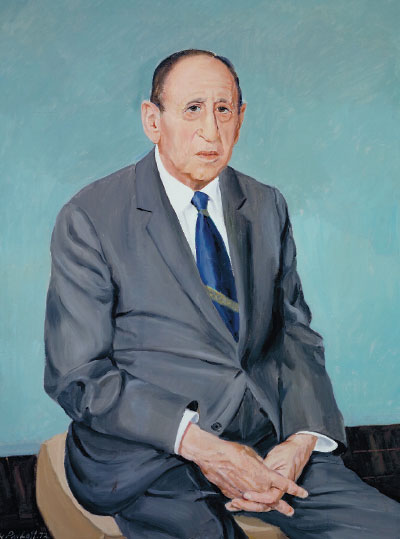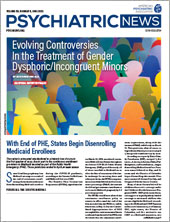The life of Leo Kanner, M.D., encompassed, by his own account, far more than the first description of autism in English. Much of his personal journey is described in an unpublished autobiography that is preserved in APA’s Archives; it illuminates an extraordinary life yet barely mentions the psychiatric condition for which he is best known today.
In the undated 419-page typewritten manuscript, tentatively titled “Freedom from Within,” Kanner charted his passage from an obscure corner of Eastern Europe to early 20th-century Berlin to the plains of South Dakota and finally to the august halls of Johns Hopkins School of Medicine in Baltimore. He worked on the biography intermittently from the late 1950s until his death in 1981.
Kanner was born in 1894 in the village of Klekotow (now Klekotiv, in western Ukraine), “at the eastern-most tip of the Austro-Hungarian Empire, almost a stone throw from the Russian border.” His father, Abraham, was a scholarly man who would have been happy spending his days studying Talmud had not the necessity of earning a living intervened. Klara, his mother—“beautiful, vivacious, and pert,” in Kanner’s words—had some secular education and was determined that young Chaskel Lieb Kanner should enjoy more of the same.
He lived a multilingual life from an early age, he recalled. “At the age at which the average child is enrolled in first grade, I spoke Yiddish, could converse in Ruthenian [a local Slavic language], read and wrote Hebrew, and had a smattering of Aramaic.” His mother, with an eye on wider horizons, hired a tutor to teach him German and Polish.
A family business failure sent the Kanner family to Brody, “ten people crowded into four poorly furnished rooms.” After elementary school, he went to the Rudolf Gymnasium. Classes were taught in German, and he studied geography, history, mathematics, botany, zoology, Latin, Polish, and Ruthenian. In his teens, with a first rustle of independence, he chose to call himself Leo.
In 1906, the family moved westward to Berlin, leaving behind a “bathroomless, kerosene-lit or, at best, gas-lit, polyglot, crazy-quilted culture … on my way to a more uniform, more standardized, unilingual, mostly organized environment. ...” He was proud of his fluency in German, extending even to minor 19th century novelists.
He began medical school in 1913. The world seemed rosy, as so many others at the time thought.
“Medicine had reached its peak. You could marvel at the progress made in bacteriology, asepsis, anesthesiology, pathology, and surgery. Certain diseases, such as general paresis or pernicious anemia, were incurable and would remain so. … Everything was set for generations to come, in matters big and little, general and specific.”
That delusion lasted until the guns of August 1914 spoke, and World War I began. Kanner volunteered and became a civilian medical scribe for a hospital commander on the Eastern Front. “My spirits were crushed. For this I had interrupted my medical studies and saddened my parents! I had no one but myself to blame for my impulsive act.”
Later in the war, he served as a medic in another Austro-Hungarian hospital unit, working “incessantly—bandaging, holding limbs while they were cut off, giving injections, having the sick and wounded talk to me about their families, and trying naively to make things as comfortable as possible for the sad, taciturn, tirelessly toiling surgeons.”
After the war, in 1919, he graduated from medical school with “Very Good or Good grades in all subjects except psychiatry, in which I was rated as ‘Satisfactory.’ ” He worked at the Charité Hospital in Berlin, got married, and set up a private practice in his apartment. “For a while I had two waiting rooms—one in which I waited and the other in which nobody waited. But people began to come.”
At that time, doctors from all over the world traveled to Berlin and Vienna for advanced study. One of those was Louis Holtz, M.D., of Aberdeen, S.D., whom Kanner met at a postgraduate electrocardiography course in Berlin.
Kanner by then was restless and ready for a change. Holtz found a position for him at the Yankton, S.D., State Hospital. Family members cautioned him against the move, fearful that in America he would fall victim to Plains Indians or gangsters in the city streets.
Unconcerned, he and his wife and daughter boarded a ship for New York in 1924. At sea, he wrote: “The past was behind us and every knot removed us farther from it. The future lay ahead, vague, unstructured, neutral, neither promising nor threatening. … Everything was drenched in beauty.”
He made his first ward rounds on February 18, 1924, at Yankton. His minimal training in psychiatry mattered not at all. “All that physicians needed was a diploma from a medical school; they became a psychiatrist by dint of their employment in a mental hospital, where they took care of the physical ills of the inhabitants and learned to look erudite when they cast their vote on whether a patient had dementia praecox, manic-depressive psychosis, paranoia, general paresis, senile, alcoholic, epileptic, or ‘undiagnosed’ psychosis. Even this was more than most universities taught them.”
Kanner overcame his initial stumbles with the English language by studying the dictionary, working crossword puzzles, and reading novels flowing from the Book-of-the-Month Club. “I was flattered when Dr. Curt Richter, the prominent psychobiologist, asked me in what part of South Dakota I was born.”
After a few years in Yankton, Kanner longed for greater intellectual challenges. A fellowship in psychiatry with Adolph Meyer at Johns Hopkins presented an opportunity to advance psychiatric knowledge for pediatricians. He began work November 1, 1930, at the Harriet Lane Home for Invalid Children at Hopkins. The Home and the Henry Phipps Psychiatric Clinic were physically adjacent but divided, linked only by a locked door. Within a year of Kanner’s arrival, however, the door was always left unlocked. Symbolically, he said, the portal “now connected, rather than separated the two departments.”
In time, the connections between psychiatry and pediatrics strengthened into a distinct new specialty—child psychiatry—and Kanner would go on to write the first textbook in that field.
He expressed great warmth about his time at Hopkins, especially his mentors, the psychiatrist Adolph Meyer and pediatrician Edwards Park. Hopkins, he wrote, was a place “of fine, hard-working men and women with ideas, whose first and foremost desire was to help sick people and to impart their knowledge and ideals to the succeeding generation.”
“He was devoted to Hopkins,” said Catherine DeAngelis, M.D., the former editor of the Journal of the American Medical Association, who lived in the same apartment building with Kanner when she was an intern at Hopkins.
Curiously, the autobiography does not mention Donald T., the patient who introduced Kanner to autism in 1938, although he did discuss Donald in an oral history interview in 1966. Nor does he refer to the now-classic 1943 paper—“Autistic Disturbances of Affective Contact”—forever associated with Kanner’s name.
Kanner ended the manuscript with a plea “for common sense, clear thought and expression, humaneness, decency, and scientific honesty” in psychiatry.
Three threads surface repeatedly in this work. One is his genuine interest in other people. Recalling his school days, he wrote: “I developed the hobby of collecting people. Anybody who crossed my path … became a fascinating item of curiosity.” At Yankton, he sought to learn more about patients than was revealed by a rote list of questions and orientation as to place, time, and person: “I might say that my interest in the patients as people—unusual ones at that—took precedence over any abstract generalization about psychiatry.” At Hopkins, it coalesced into his “capacity for entering the world of the child,” as one former student said.
A second theme was disenchantment with rigid ideologies of any kind, beginning with his early skepticism about the Jewish texts and practices that so consumed his father and extending to the brutal political ideologies that wrecked Europe in his lifetime and the unsupported verities of Freudian psychoanalysis.
The third shadow hovering through.out his autobiography is the recollection of people from his childhood onward who escaped, survived, or were slaughtered in the Holocaust. “My 70-year-old mother was dragged from her home and gassed somewhere in Bohemia,” he wrote. “My brother Willy was shot to death in Poland; my aunt Stefa and her husband were ferreted out and ‘liquidated’ in Holland.”
If he could not save his family, Kanner did help 200 refugee physicians, academics, and others to find a home and employment in the United States between 1938 and 1942. He wrote documents in their support and constantly lobbied the generally unfriendly, foot-dragging American diplomats overseas charged with issuing visas. Among those Kanner helped bring to this country were two other researchers on children’s mental health, George Frankl and Anni Weiss, who came to Hopkins for a time after working with Hans Asperger in Vienna.
While the autobiography does note Kanner’s pleasure working with colleagues at Hopkins, his academic career there was marked by a peculiarity of medical school tradition that dictated that only one full professor could serve in each department. Although he became an associate professor of psychiatry in 1933, he was not named a professor until 1957, when the practice began to disappear. Kanner retired in 1959. He then served as an occasional visiting professor at other medical schools and was the first child psychiatrist to deliver the Maudsley Lecture in London in 1958, according to APA’s archives. He died in 1981.
In the end and despite its length, Kanner’s manuscript feels somehow incomplete, even as it reveals some of the internal workings of the man. One might wish for some kind of summing up and perhaps something more about the insights that led to his work on infantile autism. Yet this manuscript is what he chose to leave behind, and it serves at least as a starting point for understanding Leo Kanner and his times. ■

